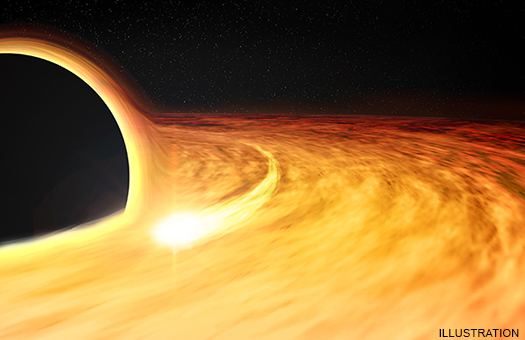For Release: January 9, 2019
NASA/CXC

Credit: Illustration: NASA/CXC/M.Weiss; X-ray: NASA/CXC/MIT/D. Pasham et al: Optical: HST/STScI/I. Arcavi
Press Image, Caption, and Videos
In a galaxy far away, a star wandered too close to a giant black hole and was ripped apart by immense gravitational tidal forces. This catastrophe triggered a burst of light first observed in late 2014. Now astronomers have estimated how quickly that supermassive black hole is spinning, a fundamental trait of these exotic objects that has been hard to pin down.
The optical outburst was detected on November 22, 2014 in a galaxy 290 million light years from Earth by the All-Sky Automated Survey for Supernovae (ASASSN), a network of telescopes that gives the source its name, ASASSN-14li. After the detection, astronomers used other telescopes including NASA's Chandra X-ray Observatory, ESA's XMM-Newton and NASA's Neil Gehrels Swift observatory, to study the X-rays emitted as the remains of the star swirl toward the black hole.
The combined observations revealed a rise and fall in X-ray brightness that repeats every 131 seconds, which is likely associated with hot gas orbiting very near the point of no return, called the black hole event horizon. The radius of the black hole event horizon depends on the geometry of space-time around a black hole, which depends on the mass of the black hole and how rapidly it is spinning. Spacetime itself rotates for a spinning black hole, and this is what drags material around it.
Astronomers can estimate a black hole's mass relatively easily from a relationship between it and the properties of the host galaxy. Getting good estimates of black hole spin, on the other hand, have been notoriously difficult.
"The fact that we can track this region of bright X-ray emission as it circles the black hole lets us track just how quickly material in the disk is spinning," said Dheeraj Pasham of the Massachusetts Institute of Technology, who led a paper just published in Science about these results. "That gives us information about the spin rate of the supermassive black hole itself."
The observations imply that the black hole's event horizon and space-time are spinning rapidly, at about half the speed of light or faster.
"This black hole's event horizon is about three hundred times bigger than the Earth," said co-author Ron Remillard, also of MIT. "Yet the black hole is spinning so fast it completes one rotation in about two minutes, compared to the 24 hours it takes our planet to rotate."
Scientists have determined spin rates for some stellar-mass black holes (those that typically weigh between 5 and 30 solar masses) in our Milky Way galaxy by observing rapid and regular variations in their X-ray brightness. A few supermassive black holes have shown similar variations, but they were only observed to repeat over a few cycles, rather than the 300,000 cycles seen for ASASSN-14li. With only a few cycles, the association of the variations with the spin of the black hole is not secure.
Material falling towards a spinning black hole is the most efficient known way to produce energy, with the exception of matter and antimatter annihilation, which only occurs on tiny scales. A non-rotating black hole is six times more energy efficient than the nuclear reactions that power the Sun, and a black hole spinning at the maximum rate is 42 times more efficient.
"A non-spinning black hole is already an extraordinarily powerful object", said co-author Chris Fragile of the College of Charleston in South Carolina. "With rapid spin the black hole's power is turned up even higher."
These results will encourage astronomers to observe future tidal disruption events for long durations to look for similar, regular variations in their X-ray brightness.
"More detections in the future would allow us to probe the dynamics of material very close to the black hole and could allow us to understand more about how matter behaves under extreme gravity," said co-author Alessia Franchini from the University of Nevada Las Vegas.
These results appear in a paper in the latest issue of the journal Science, and were presented at the 233rd meeting of the American Astronomical Society meeting in Seattle, WA. A preprint is also available online. NASA's Marshall Space Flight Center in Huntsville, Alabama, manages the Chandra program for NASA's Science Mission Directorate in Washington. The Smithsonian Astrophysical Observatory in Cambridge, Massachusetts, controls Chandra's science and flight operations.
Other materials about the findings are available at:
http://chandra.si.edu
For more Chandra images, multimedia and related materials, visit:
http://www.nasa.gov/chandra
Media contacts:
Megan Watzke
Chandra X-ray Center, Cambridge, Mass.
617-496-7998
mwatzke@cfa.harvard.edu


